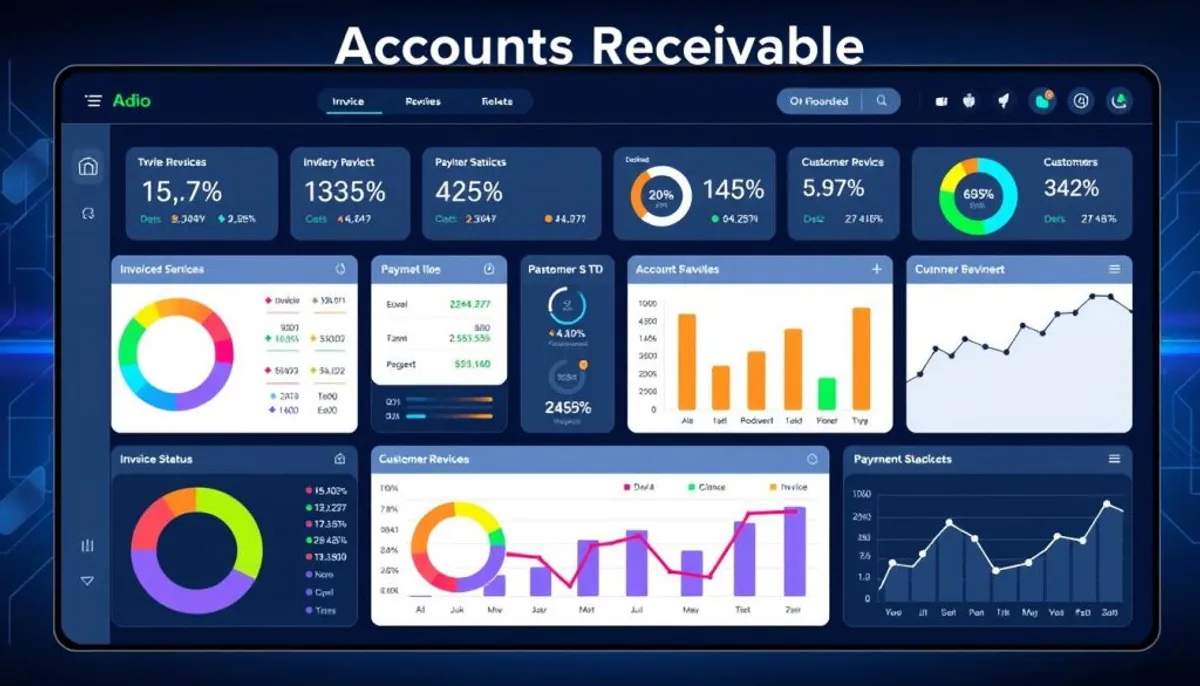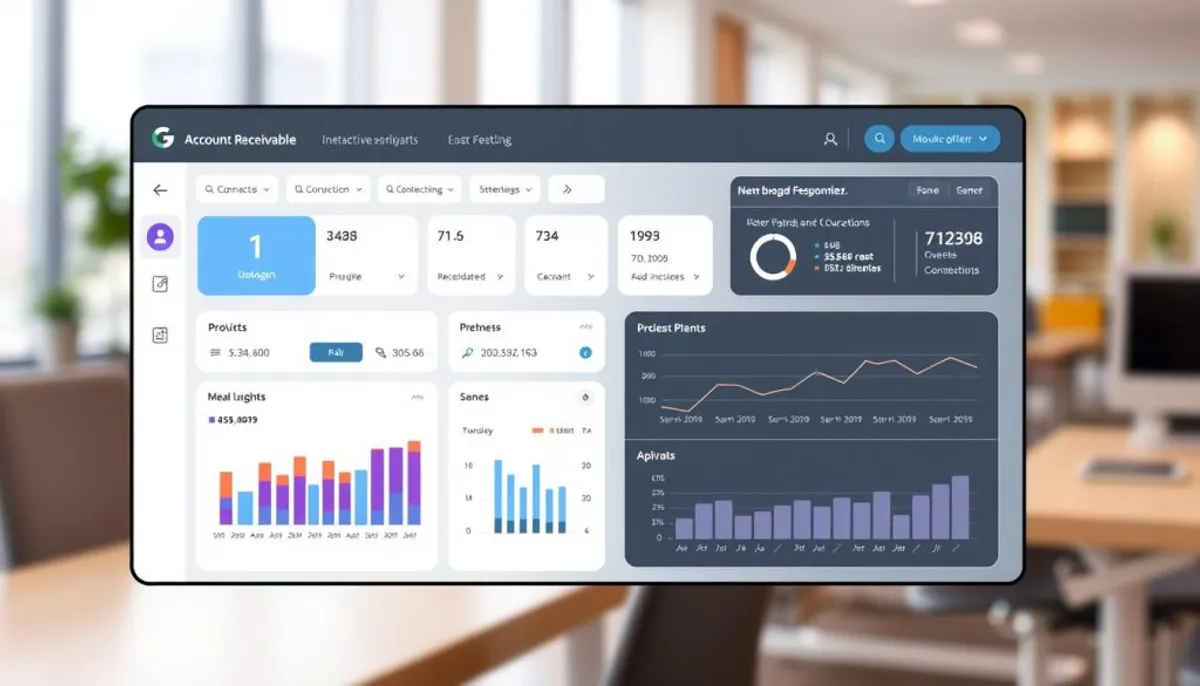Managing finances can be a real headache for small business owners. That’s where accounts receivable software comes in handy. These nifty tools help streamline invoice management and billing automation, making it easier to keep your cash flow healthy.
Our team of experts has reviewed over 250 small-business products, bringing together 95+ years of combined experience in small-business finance. We’ve carefully selected the cream of the crop across 75+ categories of business software to help you make the best choice for your company.

With the right accounts receivable software, you can say goodbye to late payments and hello to smoother operations. These tools automate tedious tasks, reduce errors, and free up your team to focus on growth. Plus, they can help you build stronger relationships with your customers by ensuring clear, timely communication about payments.
Key Takeaways
- AR software automates invoice tracking and payment collection
- It improves cash flow and reduces manual data entry errors
- Top solutions include Centime, Invoiced, and Tesorio
- Features range from basic invoicing to AI-driven finance solutions
- The right tool can streamline operations and boost customer relations
Understanding Accounts Receivable Software Fundamentals
Accounts receivable software is a transformative tool for businesses, automating key financial tasks. It streamlines the creation of invoices, manages payment processing, and maintains customer ledgers. This innovation is crucial for small enterprises aiming to optimize their financial management.
What is Accounts Receivable Automation
Accounts receivable automation transforms traditional financial processes into digital, efficient workflows. It eliminates the need for manual tasks such as invoice generation and payment tracking. This advancement significantly minimizes errors and accelerates the accounts receivable cycle.
Key Benefits for Small Businesses
AR software offers significant advantages to small businesses:
- Enhanced cash flow management
- Reduced errors in financial records
- Freed up staff time for strategic tasks
- Improved customer relationships through efficient billing
How AR Software Streamlines Financial Operations
AR software centralizes financial operations, enhancing collections management efficiency. It provides real-time payment updates, automates overdue account reminders, and offers comprehensive reporting tools. This centralization ensures accurate customer ledgers and boosts overall financial health.
| Process | Without AR Software | With AR Software |
|---|---|---|
| Invoice Creation | Manual, time-consuming | Automated, quick |
| Payment Tracking | Prone to errors | Accurate, real-time |
| Collections Management | Reactive, delayed | Proactive, timely |
Top Accounts Receivable Software Solutions for 2024
The landscape of accounts receivable software is rapidly evolving, providing powerful tools for optimizing cash flow and credit control. In 2024, several platforms have emerged as leaders, distinguished by their innovative features and ability to streamline debtors reconciliation processes.
QuickBooks Online and FreshBooks lead the market, catering to diverse businesses and freelancers respectively. These platforms boast robust AR automation features, making them favorites among small to medium-sized enterprises.
For larger corporations, Billtrust stands out in the AR automation market. HighRadius excels in complex cash application processes, while Bill.com is perfect for mid-sized businesses seeking efficient AR management.
Versapay is notable for its collaborative invoicing workflows, and Lockstep prioritizes customer self-service. Centime offers an all-in-one solution for both AR and AP automation, appealing to businesses seeking comprehensive financial management tools.
| Software | Key Feature | Pricing |
|---|---|---|
| Hiver | Versatile plans | Free – $79/user/month |
| Invoiced | Small team focus | Starting at $400/month |
| BILL | Mid-size business solution | $45 – $55/user/month |
| Tesorio | Advanced reporting | Custom pricing |
These software solutions offer various pricing models to suit different business needs, from free plans to custom enterprise solutions. When selecting AR software, consider integration capabilities, automation features, and specific industry requirements. This will help optimize your cash flow management and credit control processes.
Essential Features of Modern AR Software
Modern accounts receivable software equips businesses with advanced tools to streamline financial operations. It addresses common challenges in receivables management, thus enhancing efficiency and cash flow.
Invoice Management Capabilities
Advanced AR software simplifies billing automation. It generates accurate invoices swiftly, reducing errors and accelerating payment cycles. Custom templates and automatic delivery ensure professional, timely billing.
Payment Processing Tools
Efficient payment tracking is essential. AR software offers various payment options, making it convenient for customers to pay. Online portals and integrated gateways streamline transactions, enhancing cash flow.
Automation and Reminder Systems
Automated reminders are crucial for reducing late payments. AR software sends timely follow-ups, freeing staff from manual tasks. This systematic approach to receivables aging helps maintain healthy cash flow.
Reporting and Analytics Functions
Robust reporting tools offer insights into payment trends and customer behavior. AR software provides detailed analytics on receivables aging, aiding businesses in making informed decisions. These features enable proactive management of accounts receivable.
| Feature | Benefit |
|---|---|
| Billing Automation | Reduces manual errors, speeds up invoicing |
| Payment Tracking | Improves visibility, enhances cash flow |
| Automated Reminders | Decreases late payments, saves time |
| Analytics | Provides insights, aids decision-making |
By leveraging these features, businesses can significantly improve their accounts receivable processes. This leads to better financial health and customer relationships.
Introducing ti3: A New Era in AR Management
The landscape of accounts receivable software is undergoing a transformative shift. ti3 stands out as a revolutionary force in collections management, introducing a novel methodology for managing overdue accounts.
Automated Payment Collection System
ti3’s automated framework revolutionizes the collections process. It initiates timely reminders, escalates issues when necessary, and ensures seamless payment collection. This efficiency is paramount for small enterprises aiming to enhance their cash flow.

Client Relationship Preservation
ti3 diverges from conventional methods by emphasizing the preservation of client relationships. Its approach is both gentle and effective, enabling businesses to recover funds without jeopardizing their customer connections. This delicate balance is essential in today’s fiercely competitive market.
Cost-Effective Alternative to Collection Agencies
ti3 presents a cost-effective alternative to traditional collection agencies. Small businesses can manage their accounts receivable internally, thus avoiding the exorbitant fees associated with agency services. This cost-effectiveness does not compromise on outcomes, positioning ti3 as a compelling choice for businesses across various scales.
| Feature | ti3 | Traditional Collection Agencies |
|---|---|---|
| Cost | Low monthly fee | High percentage of collected amount |
| Client Relationship | Preserved | Often strained |
| Process | Automated | Manual |
| Ease of Use | User-friendly platform | Complex procedures |
Adopting ti3 can significantly enhance job performance and satisfaction within accounts receivable departments. The platform’s intuitive interface and automated functionalities minimize the learning curve, addressing the typical hurdles organizations encounter when integrating new technologies.
Integration Capabilities and Compatibility
Modern accounts receivable software excels in integrating with other business tools. This integration boosts invoice management, customer ledger accuracy, and payment tracking efficiency. Leading AR solutions feature built-in capabilities that harmonize with well-known accounting platforms, forming a cohesive financial environment.
BILL’s AR system, for example, offers automatic 2-way sync with QuickBooks Online, Xero, and Oracle NetSuite. This integration minimizes manual data entry, reducing errors and saving time. Automation in finance can reclaim up to 30% of an employee’s time, typically spent on avoidable rework.
Integration goes beyond accounting software. Payment gateways, CRM tools, and ERP systems can also connect with AR software, creating a comprehensive financial management suite. This interconnectedness streamlines operations, leading to significant benefits:
- 77% reduction in receivables at risk
- 60% decrease in overdue invoices
- 30% improvement in days sales outstanding
By selecting AR software with strong integration capabilities, businesses can establish a unified financial ecosystem. This approach not only improves invoice management and payment tracking but also offers a clear, real-time view of the customer ledger. The outcome? Enhanced cash flow, reduced errors, and faster collections – all vital for small business success.
Pricing Models and ROI Considerations
When selecting accounts receivable software, it’s crucial to assess pricing models and potential return on investment. Businesses must weigh the costs against the benefits of enhanced cash flow optimization and streamlined billing automation.
Subscription-Based Options
AR software providers often present tiered subscription plans. These range from entry-level options for small businesses to comprehensive solutions for larger corporations. Pricing is usually adjusted based on the number of invoices processed or the features included.
| Plan | Monthly Cost | Invoice Limit |
|---|---|---|
| Sole Proprietor | $49 | 100 |
| Small Business | $99 | 500 |
| Enterprise | $199 | Unlimited |
Pay-Per-Use Models
Some providers adopt a pay-per-use pricing strategy. Here, businesses are billed according to the volume of transactions or invoices collected. This approach can be more economical for companies with variable AR volumes.
Enterprise Solutions
Large corporations frequently require bespoke enterprise solutions. These include advanced features such as AI analytics and support for multiple entities. Pricing for these solutions is typically customized to meet specific business requirements and scale.
When evaluating ROI, companies should focus on potential improvements in cash flow and billing efficiency. For instance, some users have seen a 25% drop in past-due payments and a 20% reduction in days sales outstanding post-implementation. Opting for annual payments can lead to savings of up to 20% on subscription costs, boosting ROI further.
Security and Compliance Features
When selecting accounts receivable software, prioritizing security and compliance is essential. Leading solutions focus on data protection and regulatory compliance. This ensures the safety of your financial data and fosters trust with clients.
High-quality payment tracking systems utilize advanced encryption techniques. These methods protect sensitive information from unauthorized access. User access controls further enhance security, allowing you to dictate who can access and modify financial records.
Compliance with financial regulations is a non-negotiable aspect. Seek out accounts receivable software that adheres to standards such as PCI DSS for payment card data. This guarantees your business’s adherence to legal requirements during transactions.
Some cutting-edge accounts receivable software incorporates fraud prevention tools. These tools identify and flag suspicious activities, enabling early detection of potential issues. Vendor verification features also play a crucial role, confirming the authenticity of your business partners.
Regular security audits and updates are indispensable. They ensure your accounts receivable software remains effective against emerging threats. By focusing on these security and compliance aspects, you are making a significant investment in your business’s financial well-being and reputation.
User Experience and Interface Design
The user experience of accounts receivable software is pivotal for its adoption and effectiveness. A well-crafted interface simplifies invoice management and enhances customer ledger accessibility. This makes financial tasks more efficient for small businesses.
Mobile Accessibility
Modern AR software offers mobile access, enabling businesses to manage receivables on the move. This feature allows for rapid invoice reviews, payment approvals, and customer ledger updates from smartphones or tablets. It boosts flexibility for finance teams.
Dashboard Customization
Customizable dashboards provide immediate insights into AR performance. Users can configure their views to highlight essential metrics like outstanding invoices, payment trends, and cash flow projections. This customization enables businesses to focus on the most critical data for their invoice management needs.

Client Portal Features
Client portals offer self-service options for customers to view invoices and make payments. These portals typically include features like:
- Real-time invoice access
- Secure online payment options
- Historical transaction records
- Ability to update account information
By providing these tools, businesses can enhance customer satisfaction and decrease the time spent on invoice-related inquiries.
Intuitive interfaces in AR software reduce training time and enhance efficiency for finance teams. For instance, Kolleno’s platform integrates receivables, payments, and reconciliation with AI-powered insights. It streamlines the entire invoice management process. Sidetrade also employs AI to suggest optimal dunning actions, improving collection efficiency and predicting customer payment behaviors.
Customer Support and Training Resources
Adopting accounts receivable software can be daunting, yet, with comprehensive support and training, the journey becomes less arduous. Leading AR software vendors offer a variety of support avenues to aid businesses in optimizing their investment.
Many AR software entities provide weekday phone support, ensuring prompt resolution of critical issues. Email and live chat are also prevalent, enabling users to seek assistance at their convenience. For those in higher-tier plans, dedicated account managers offer bespoke support.
Training resources are pivotal for proficient collections management. These typically encompass:
- Onboarding assistance
- Video tutorials
- Comprehensive knowledge bases
- Regular webinars
These tools expedite teams’ transition to new AR processes, diminishing the learning curve and enhancing operational efficiency. With adequate support and training, businesses can maximize their AR software, facilitating quicker payments and enhanced cash flow.
| Support Feature | Benefit |
|---|---|
| Weekday Phone Support | Quick resolution of urgent issues |
| Email and Live Chat | Convenient help at user’s pace |
| Dedicated Account Managers | Personalized assistance for complex needs |
| Video Tutorials | Visual learning for easier adoption |
| Knowledge Base | Self-service problem-solving |
Implementation and Onboarding Process
Adopting new accounts receivable software requires meticulous planning and execution. The journey involves setting up the system, migrating data, and training staff. Let’s dive into these essential steps to ensure a seamless transition to your new billing automation system.
Setup Requirements
The setup phase begins with configuring payment gateways and customizing invoice templates. Establishing automation rules for tasks like sending reminders and updating receivables aging reports is also crucial. This foundational work is essential for maximizing the software’s efficiency.
Data Migration Steps
Transferring existing data is a pivotal phase. This entails moving customer information, open invoices, and payment history. Companies like Trimble Viewpoint have successfully migrated thousands of customers using proven methodologies. Regular weekly status meetings ensure the project stays on track.
Staff Training Needs
Effective training is vital to unlock the full potential of the new system. A combination of self-guided and instructor-led courses is most effective. Highlight key features such as automated reminders, personalized emails for late payments, and customizable dashboards. Proper training enables staff to transition from manual tasks to more strategic roles, enhancing financial operations.
The ultimate goal is to streamline your accounts receivable process, improve cash collection, and maintain robust customer relationships. With a well-executed implementation strategy, you’ll be poised to benefit from your new AR software.
Real-Time Analytics and Reporting Tools
Modern accounts receivable software now offers advanced real-time analytics and reporting tools. These innovations are pivotal for optimizing cash flow and reconciling debtors efficiently. They redefine how businesses manage their finances.
These platforms deliver in-depth insights through various reports, including accounts receivable aging, cash flow forecasts, and customer payment behavior analysis. Such data enables businesses to refine their collections strategies and credit policies, making informed decisions.
Real-time tracking of invoice statuses and automated payment reminders are essential in many AR solutions. For instance, Xero’s software includes these functionalities, along with support for multiple payment gateways. This enhances flexibility for both businesses and their customers.
Some AR software extends beyond basic reporting. HashMicro’s solution, for example, offers forecast budget tools and financial ratio analysis. These advanced features provide a comprehensive financial health overview. They support both short-term cash flow optimization and long-term financial planning.
| Feature | Benefit |
|---|---|
| Real-time invoice tracking | Improved cash flow visibility |
| Automated reminders | Faster payment collection |
| Financial ratio analysis | Better decision-making |
| Cash flow forecasting | Proactive financial planning |
With these tools, businesses can notably reduce human errors, lower operational costs, and expedite invoice processing. This leads to a more efficient accounts receivable process. It supports overall financial health and growth.
Conclusion
Accounts receivable software has revolutionized the landscape for small businesses in 2024. Midsize organizations leverage over 112 SaaS applications to bolster their finance teams. This underscores the critical need for streamlined invoice management and billing automation. Such tools can liberate teams from up to 60 hours weekly of unpaid invoice handling, redirecting this time towards strategic planning and expansion.
The adoption of suitable accounts receivable software can markedly enhance cash flow and customer engagement. By introducing diverse payment options and automating subscription management, businesses can achieve consistent cash flow and diminish bad debt risks. The automation of AR processes significantly reduces dispute resolution time, enhancing overall customer satisfaction through swift identification and resolution.
In selecting AR software, prioritize features such as automation capabilities, integration options, and user experience. E-invoicing can slash costs by up to 39%, while AR automation can save companies up to 25,000 hours in finance processes. By optimizing financial operations with the appropriate AR solution, small businesses can concentrate on their core objectives: business growth and superior customer service.
RelatedRelated articles



